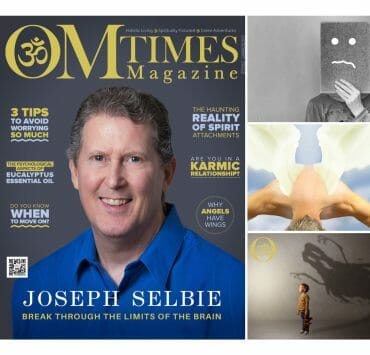Joseph Selbie: Break through the Limits of the Brain

Joseph Selby is the author of The Physics of God, how the deepest theories of science explain religion, and how the deepest truths of religion explain science. A dedicated Kriya meditator for nearly 50 years. He’s taught yoga and meditation throughout the US and Europe. He has helped hundreds of people awaken to their own spiritual potential. He’s a founding member of Ananda, a worldwide spiritual movement inspired by Paramahansa Yogananda. His latest work is Break through the Limits of the Brain.
An Interview with Joseph Selbie: Break through the Limits of the Brain and the Science of Non-Local Realities
Interview by Sandie Sedgbeer
Have you ever wondered why superhero comics and movies are so popular with adults and children? Well, it’s because we all harbor a secret hankering to be one. Who wouldn’t want to have an array of amazing Amazonian superpowers to call upon? The problem is that we can only find them in comics and movies. Right? Well, actually, no, because according to Dean Radin, MS, Ph.D., the Chief Scientist at the Institute of Noetic Science (IONS) and author of the book Real Magic, the book we will discuss today is not just an accelerating read. It’s the definitive User manual for superheroes.
Joseph Selbie joins us to discuss his latest book: Break through the Limits of the Brain, which connects the dots between the discoveries of neuroscience and the meditation-born spiritual experience and provides proven, practical exercises to help you achieve your superconscious potential.
To listen to the full interview of Joseph Selbie by Sandie Sedgbeer on What Is Going OM on OMTimes Radio, click the player below.
 Sandie Sedgbeer: So, we are hearing it more and more these days that we are so much more than we know, and your latest book, Break through the Limits of the Brain, underscores that with scientific support, for the existence of the subtle non-local reality, that suggests we exist simultaneously into realities, and also that our thoughts, emotions, memories, and life force originate non locally. So tell me more about this.
Sandie Sedgbeer: So, we are hearing it more and more these days that we are so much more than we know, and your latest book, Break through the Limits of the Brain, underscores that with scientific support, for the existence of the subtle non-local reality, that suggests we exist simultaneously into realities, and also that our thoughts, emotions, memories, and life force originate non locally. So tell me more about this.
Joseph Selby: Well, I think the heart of where science and spirituality intersect is in this concept of non-locality, that there is a realm that physics acknowledges not only does exist but must exist to explain how the physical universe works. But this other reality is called non-local reality because it doesn’t behave exactly the same way as our local reality does. So in our local reality, we have certain laws that are affected by distance. So, for example, the strength of a magnet tails off dramatically the farther away any metal object is from its magnetic center. And so, you can say that’s affected by distance. Still, non-locality has laws that aren’t affected by distance because there is no distance in the non-locality. There is no space in a non-locality, and it’s very challenging to visualize what that could be.
But at the same time, physics is very solidly committed. And in fact, some thinkers say that without this non-local reality, you could not have quantum physics. You just can’t have one without the other. And this is really speaking to the same spiritual truths put forward by saints, sages, and mystics that we simultaneously inhabit as two realities. They’re different. One is the physical world that is revealed to us by the senses. The other is a world that we experience subjectively. That other world is the world from which our thoughts, our emotions, our memories, and our mind, as opposed to the brain, actually originate. So the brain coordinates sensory data and also sends commands to the motor parts of the body so that we move our muscles, we walk, we talk, but when we think, we’re using our mind, we are more in that non-local reality than we are in the local reality.
That is our physical body. But the two work together seamlessly, and this concept exists in spiritual teachings in the form of the subtle body, the energy body, and the Astral body, which you find in nearly every experiential spiritual tradition around the world, and throughout the ages that we are so much more than we know. We are, in fact, these luminous beings that exist beyond the physical body, and even more than that, we are inherently divine. We are children of the divine and are heirs to every aspect of the divine. We just don’t know it. We don’t perceive it all the time because we tend to be caught up in what the neural circuits we formed in the brain keep us constantly aware of, which is the physical body rather than the subtle body.
Sandie Sedgbeer: So, the brain is the machine that runs the body. Maybe a receiver that receives instructions from the other reality, perhaps? Certainly, if that’s where our thoughts are. So, tell me what happens when, if my thoughts are there. If my emotions and memories are there too, then how is it that I don’t know? What else is there?
Joseph Selby: Well, you know, it in one sense, because you experience it all the time, you know, you have thoughts, nobody could talk you out of the notion that you think, and that you feel, and that you have memories. But it’s confusingly difficult to separate the notion that there’s a physical body and an Astral body or energy body because they are occurring simultaneously. You use the phrase, “my thoughts are out there, and my feelings are out there,” but they’re not. They’re right here where you are. And that confounds the mind because the mind wants to say, well, it’s either here or there. It’s either this or that kind of reality, but they exist simultaneously. So, we have all these subjective experiences that, even though we call them subjective, science that likes objective realities is slightly dismissive about the actual reality of subjective experience. They say it’s fuzzy and different for different people, but that doesn’t deny the fact that it’s a major part of who we are. If we didn’t have our thoughts if we didn’t have our feelings, if we didn’t have our memories, what exactly would be left? You know, it’s difficult to conceive.
Sandie Sedgbeer: Well, many people face that they don’t have their memories.
Joseph Selby: Yeah, extreme brain damage can eliminate, uh, memories because that intricate relationship between brain and mind, between the non-local brain and, or excuse me, local brain and non-local mind, is complex. I describe it in my book as you have neural circuits that act like preset buttons on a radio. So, if you have a radio set up and it is programmed to give you the stations that you often tend to listen to, all you have to do is press a button. You’re listening to that radio station. So we have circuits in our brain that effectively stimulate trains of thought or trains of memory, the experience of emotions that happen automatically when different stimuli come. So the stimulus is sensory. So, let’s say you hear a song. That song can trigger a neural circuit that gets you thinking about what you experienced the last time you listened to that song or the feelings you have about that song. So, you have both things happening simultaneously. You have a local experience triggering a non-local experience. And then, as you said yourself, you can have non-local decisions that tell the physical body what to do. So it’s a seamless, intricate, amazing connection between the two, but very much a real one.
Sandie Sedgbeer: I can understand entanglement. I can understand a lot of things. But, what I can’t understand is if there’s so much that we can access, if we can get beyond the limits of the brain, there’s so much, this is what your book is all about. There’s so much more that we can access, a super consciousness. What happens when someone has a heart transplant, and we hear about them having the likes and the dislikes of the other person’s heart, or maybe even a memory, you know, what has happened there? Is that entanglement, or is that something else entirely?
Joseph Selby: Well, it speaks to entanglement, but whether entanglement is a specific phenomenon. The more general phenomenon is when you have coherent and decoherent states of matter. So, when things are entangled, they’re in a coherent state. So that means they exist more specifically in the energy world of non-locality, and they haven’t taken a specific physical form yet in the physical world. And so they haven’t “decohered.” They haven’t lost that deeper connection that they have in non-locality yet, because they haven’t been observed. So matter, generally, can be in coherent states that aren’t necessarily entangled. You can have multiple, even thousands of molecules that are in coherent states. We see this in photosynthesis. The amazing efficiency of photosynthesis is because the chlorophyll molecules remain in an entangled coherent state. They can pass the energy on from the sun to other parts of the mechanism for storing solar energy in plants in a very efficient manner. And so there are states where they’re decoherent, essentially in an energy form. Then they become less coherent and finally decoherent when they cease doing that channeling of the sun’s energy. So entanglement is one expression of coherent and decoherent states.
So we can be in our processes, more coherent or less coherent. And I think that is the answer to how you could get a heart transplant. It would come with the memories or feelings, or as you say, the likes and dislikes of another person because it becomes decoherent when it’s in your physical body. You lose those connections, but it can open up, become coherent, and connect to its memories and feelings. This may sound completely bizarre, but it’s no more bizarre than saying that we have those memories, to begin with, right? It is perhaps the least bizarre explanation for how those memories can come. Those feelings can come with a heart transplant. So everything, I guess that was a long-winded way of saying that every aspect of physical reality can connect to the non-local purely energetic expression of reality that they are linked inextricably.
Sandie Sedgbeer: So, why does my brain have limits?
Joseph Selby: Well, it does, and it doesn’t. So, the title is a bit off, and not absolutely certain that your brain has limits, but what is the reality for most of us is that we have used the brain to create limits. When we were children, we had to start forming neural circuits to support our ability to first crawl and move our arms and legs to walk, learn, talk, and speak. I mean, to speak, to hear and understand spoken language, we weren’t preset to do all these things. Human infants are surprisingly unable to do almost anything that is of a voluntary nature. And so we have to build all those circuits to support our ability to do that. And if we hadn’t built the circuits to walk when we were infants every morning, when we woke up, we’d be toddlers.
It’s a very, very complex process to walk. It involves thousands of signals going to hundreds of muscles in a coordinated fashion. And we do it every day without thinking because it is automatic. Well, the programming we did, the wiring of the brain that we did by creating all these circuits, and neural circuits are not limited to physical activity. We also have created neural circuits that support emotional reactions, that trigger trains of thought, and keep us involved. This is especially where the wiring becomes a limitation because we do thousands of millions of these circuits. So on our ordinary waking day, we are only aware of things happening from sensory experience, triggering the thoughts connected to sensory experience. And I liken this to being a firework show because one neural circuit will trigger another neural circuit, which will trigger another neural circuit.
And so we’re constantly in this reactive mode that is totally focused on the senses and the world that the census revealed to us. So this is what creates the “limit of the brain.” It’s self-created, inadvertently self-created, but we have rendered ourselves narrowly blind to anything except those specific actions and reactions that we’ve established neural circuits for most of our life. There are many cases. However, when in which young children are aware of more subtle realities, young children see angels, they have astral awareness, and they get talked out of it, or as is often the case with psychics, they work out a very confusing relationship to it, that they only realize they see things that other people don’t when they’re four or five or six or later, they start talking about things and adults start giving them very strange reactions.
And then they eventually learn that they perceive subtle realities that nobody else around perceives. So, we lose awareness, but we never lose the innate ability to reclaim it. So that’s why we have to break through the limits. We must break through the limits of our wiring and regain that awareness. So meditation is a big key to that. I can talk about it more in-depth, but essentially meditation doesn’t give you anything. Meditation gives you access to EVERYTHING. It gives you access to everything subtle that your senses don’t reveal. So the near-death experiences instantly gain access to realms beyond the physical. And then, when they return, they feel like they have been in the real world. And they came back to the fake world of three-dimensional reality; that is to them plainly a construct of their mind, a construct of their senses that they can perceive. They can work within, but they always have this deep seeded sense of its unreality because what they experienced during their near-death experiences was much more real, much truer to their heart and mind than what we tend to perceive. So, the challenge for us is to break through that self-imposed limitation.
Sandie Sedgbeer: Well, what I don’t understand is if you talk about the larger part of ourselves, most of us, what we think of as ourselves doesn’t exist. It’s non-local if that is so, and if, what I think of as me, the physical me is a hologram. So, what is the purpose of this? Why would I do this? Why would I split part of myself from what I really am to live a very diminished life?
Joseph Selby: Well, the answer that I can give you, I can’t say that I have directly experienced it with such a degree of depth that I can be certain, but I can give you the answer that most satisfies my mind and my heart, which is that we are children of God, who are returning to our awareness in God, and that this process takes place through many, many incarnations. Some of those incarnations go back to us being crystals. And that it’s hard to imagine what the beginning and end of a lifespan of a crystal would be. But nonetheless, the thought is that crystals are more organized matter than any other form of matter.
Continue to Page 2 of the Interview with Joseph Selbie
Click HERE to Connect with your Daily Horoscope on OMTimes!
Visit Our Astrology Store for Personalized Reports
OMTimes is the premier Spiritually Conscious Magazine. Follow Us On Facebook, Twitter, Instagram, Linkedin, Pinterest, and Youtube
A veteran broadcaster, author, and media consultant, Sandie Sedgbeer brings her incisive interviewing style to a brand new series of radio programs, What Is Going OM on OMTimes Radio, showcasing the world’s leading thinkers, scientists, authors, educators and parenting experts whose ideas are at the cutting edge. A professional journalist who cut her teeth in the ultra-competitive world of British newspapers and magazines, Sandie has interviewed a wide range of personalities from authors, scientists, celebrities, spiritual teachers, and politicians.







